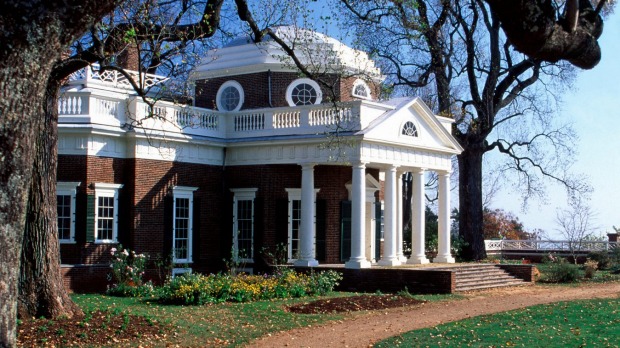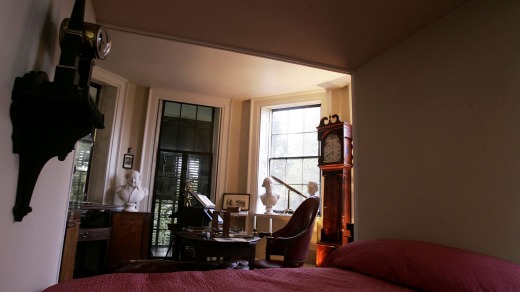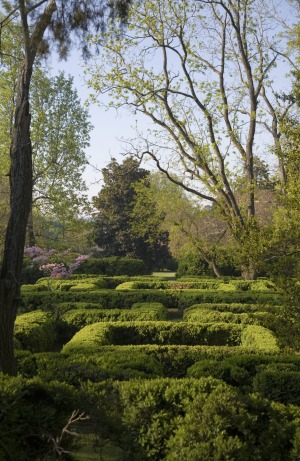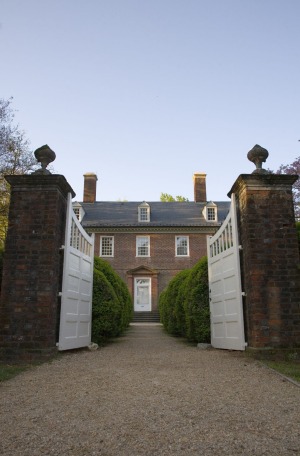
On the approach to the house is a pet graveyard. Animal-shaped headstones commemorate beloved companions loved by generations of the Tyler family, which has lived at the Sherwood Forest Plantation since 1616.
One has an epitaph engraved on it. "Here lie the bones of my old horse General. Who served his master faithfully for 21 years. And never made a blunder. Would that his master could say the same."
The words belong to John Tyler, the most famous former occupant of the plantation and 10th president of the United States. And they act as a prelude to a scene of sumptuous, historic, quintessentially Virginian prettiness.

Centuries-old woodland flanks the carefully mown lawns around the gigantic house. It's more than 90 metres long, with the white wood-framed exterior carefully maintained. Around it are the "dependencies", a collection of outbuildings. The explanatory leaflet says they sustained "the operation of an almost self-supporting community of approximately 110 people for four centuries".
There's a smokehouse, a wine house, an overseers' house and a servants' house where between 60 and 90 field hands would have lived.
It's those euphemisms that stick uncomfortably in the throat. "Community". "Servants' house". "Field hands". The linguistic leaps exercised in order to avoid any mention of slavery are astonishing. Last month it was 150 years since the 13th Amendment abolished slavery in the United States, but many in the south would still prefer to apply the airbrush instead of the magnifying glass.

It's an attitude that leads to Confederate flags being proudly flown, seen as a symbol of southern traditions and states' rights. Acknowledging that the tradition and right in question was keeping human beings as slaves? Well, that's just impolite to bring up, sir.
Virginia has a stronger connection to slavery than most states. In 1607, it was the first state to be settled by English colonists, and tobacco quickly became the passport to riches. Plantations spread out across the colony, first along the James River then further afield. And cheap labour was needed to cultivate a crop that required intensive work. Enslaved Africans, already being shipped to the Caribbean to work on sugar plantations, became the obvious answer.
By the time tobacco was replaced by wheat – prices had plummeted and tobacco ravages soil – in the late 18th century, the slavery system was firmly established.

The Berkeley Plantation, a few kilometres up the James River from Sherwood Forest, also has a presidential pedigree. The stout, Georgian red brick house was the birthplace of Tyler's predecessor, William Henry Harrison.
The grounds are similarly dreamy, with boxy formal gardens, crops still growing to the sides and lashings of blooming magnolia. The tours of the house and the little museum in the basement delve into what is in many respects an illustrious history. The first Thanksgiving service in America was held by the waterfront here in 1619; the Harrison family produced two presidents; the American bugle call equivalent of the Last Post – Taps – was composed on site while Union troops used the plantation as a base in the Civil War.
Slavery, however, is not high on the agenda. But at least it isn't ducked altogether. The tour guide admits he can't offer too much insight into the topic, as there isn't all that much documentation to show how many slaves were there and how the Harrison family treated them.
What little there is can be found inside the old coach house. Inside, there's a model of a typical early 1800s slave cabin. Very few originals are still in existence, largely because they were made out of wood and never built to last. There's also a small painting of the slave quarters at Berkeley from the 1700s.
But it's the 1791 slave inventory that offers the most chilling insight. No tales of brutality or cruelty can match up the casual administrative efficiency of listing 110 slaves by name, age and price. Some have notes by the side, either indicating a skilled job such as "blacksmith", "doctor" or "cook", or limitation. Some are described as "superannuated", others "fat" or "infant".
York, the 27-year-old blacksmith, is valued at £100. Old Isiah, an 80-year-old, has a zero next to his name. That cold, indifferent piece of accountant's housekeeping manages to tell quite an emotion-tugging story.
Harrison and Tyler, of course, are relatively obscure commanders in chief who usually come way down any list of greatest presidents. But George Washington is always top or pretty near it – and his Mount Vernon home near Alexandria gives an admirably balanced view of a man who is often lionised in the country he led to independence.
Situated on a majestic spot overlooking the wilder stretches of the Potomac River, Mount Vernon is a well-oiled tourist magnet, and the tours of the house itself are the least interesting part. The museum section at the bottom of the hill is superb, while a walk through the woodland leads to Washington's tomb and a slave graveyard.
The latter is currently being excavated in an attempt to get more information on those buried in it, a sign that Washington's complex relationship with slavery is being taken seriously. The slave quarters have also been reconstructed to give an idea of what they would have been like – imagine a sturdily constructed countryside hostel dorm where cooking has to be done in the corner rather than in a separate kitchen.
Mount Vernon also runs specific tours on the subject of slavery, and a picture emerges of a man reluctant to take a lead. Washington owned 318 slaves when he died, and his will stated that they would be freed upon his wife's death. He also stated that the children and the old and infirm slaves must be taken care of.
His treatment of the slaves seems somewhat patrician. He was interested enough in their welfare and sense of community to encourage them to marry and have families – although this handily gave would-be runaways a disincentive to disappear.
But Washington also expected them to work as hard as he did – and that meant at least dawn until dusk.
Of the nine presidents to own slaves, Washington was the only one to free them. Had he done so during his lifetime, it may have set a precedent along the lines of the one he set by refusing to serve more than two terms. It's hard not to leave Mount Vernon without a vision of a normally strong leader making one historically devastating timid fudge.
Mount Vernon provokes deep thought, but Monticello – home of third president and staggering polymath Thomas Jefferson – brings astonishment.
Just outside Charlottesville, Jefferson's hilltop home gives a strong sense of his personality, with scores of curiosities he collected from around the world on display. But the tours bring forth the stories.
Jefferson wrote the line in the Declaration of Independence that stated all men are created equal with an unalienable right to liberty. He also banned the importation of slaves during his presidency. But he kept around 200 human beings in bondage at any one time, as testified to by his own fastidious documentation. He sold some at their request so they could stay with their families, and freed five slaves in his will. These were all males from the Hemings family.
And it's while walking Mulberry Row, where the slaves would have lived, that the Hemings family story truly hits home. Elizabeth Hemings had several children by Jefferson's father-in-law. Of these children, Sally Hemings was widely believed to have had a relationship with Jefferson himself, spanning over 30 years. Six of Sally's children were believed to have been fathered by Jefferson.
Few things make the notion that this was a different world strike home like knowing that the president most obsessed with liberty kept his own children enslaved. And Virginia's presidential plantations are a disturbing, thought-provoking window on that different world.
virginia.org.
United flies to Washington Dulles via Los Angeles from Sydney and Melbourne. See united.com.
The Historic Powhatan Resort in Williamsburg – near the James River plantations – is a former plantation itself. Rooms cost from $122. See diamondhotelsandresorts.com. In Alexandria, the Hotel Monaco has a free wine hour, animal print robes and a huge sense of fun. Prices start at $206. See Monaco-alexandria.com. In Charlottesville, the homely but modern Oakhurst Inn has handy free parking and rooms from $188. See oakhurstinn.com
See sherwoodforest.org, mountvernon.org, berkeleyplantation.com, Monticello.org.
The US key foundational documents – the Declaration of Independence, the Constitution and the Bill of Rights – are on display under the National Archives building's grand rotunda. Interpretive signage goes into the grand fudge that ensured the slavery question went unaddressed in all three.
The Changing America: Slavery in America exhibition inside the Smithsonian museum devoted to the nation's history is crammed with documents, artworks and grim tales of slave life. See americanhistory.si.edu.
Not far from Mount Vernon, this museum tells the fascinating tales of the thousands of African-Americans who fled to Alexandria during the Civil War, and later helped to shape the city. Alexandria was taken early by the Union troops, and became the front line. Once there, slaves were effectively free. See alexandriava.gov/BlackHistory
The Underground Railroad was the system in which slaves were smuggled out of the slave-owning southern states to freedom in the north. Cincinnati in Ohio was a major point in the operation, with locals such as Harriet Beecher Stowe instrumental in the organisation. See freedomcenter.org.
In the South Carolina capital, this was where slaves were sold off to their new owners. Now it's a museum of shackles, whips and chilling oral testimonies. See nps.gov/nr/travel/charleston/osm.htm.